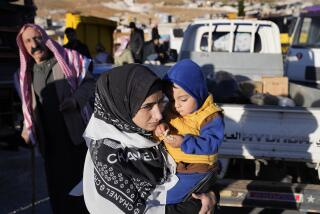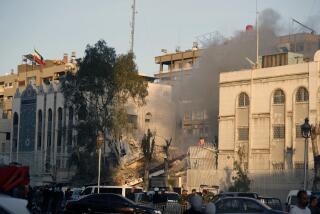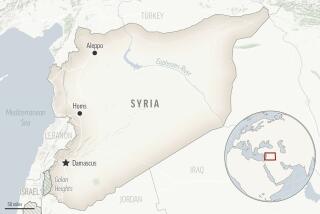Clashes flare up in strategic Syria suburb
BEIRUT — Syrian forces and antigovernment rebels fought bruising skirmishes Saturday in the rubble of Dariya, a war-torn western suburb of Damascus that both sides have identified as necessary for victory because of its proximity to the capital city’s center and the main military airfield.
Dariya, with many of its buildings leveled by airstrikes and shelling, is a symbol of the destruction of ordinary life in Damascus, which claims to be the world’s longest-inhabited city.
On Saturday, tanks tried to enter Dariya, and a MIG fighter jet shelled the neighborhood that was once home to more than 200,000 people but now has about 10,000. At least 3,000 are fighters, according to rebels and activists there.
An anonymous Syrian government official told the Associated Press that the Syrian army had advanced in the strategic suburb, but rebels said the stalemate continued.
“The Assad soldiers are trying to enter Dariya, but our Free [Syrian] Army is doing well to protect it,” said a rebel spokesman in Dariya who called himself Abu Hamza. “It is always the same situation in the afternoon.... They try to send in tanks … and soldiers try to enter the city, and our Free Army prevents them, and the war starts.”
The head of the pro-opposition Syrian Observatory for Human Rights, Rami Abdul-Rahman, also disputed the notion that anyone would win Dariya anytime soon. “The regime is present in Dariya. Both sides have control over some parts,” he said.
The opposition forces blew up a tank Saturday, and three rebel soldiers died in the fighting, Abu Hamza said.
Rebels see Dariya as essential to their goal of entering the center of Damascus and cutting off the military airport, but the fight has heavily damaged the suburb over the last year. Abu Hamza estimated that 80% of the buildings in Dariya have been damaged or leveled. Some people are sleeping outside in empty lots, and others sleep in basements to avoid the fighting, said Abu Hamza and another activist, who called himself Abed.
The area has no real medical care for the mix of fighters and civilians. Field hospitals have been set up in homes, but medical supplies and medicines are nonexistent, leading to a high death rate, Abu Hamza said. He put the number of identified dead at 1,200, with an additional 2,000 nameless corpses.
Abed described how civilians do not try to escape the suburb unless a firefight is going on at the neighborhood’s edge. There are four main checkpoints for entering the district, and locals use the exchange of fire as a diversion to flee the neighborhood, Abed said. Without the distraction of a firefight, anyone who tries to leave the area is likely to be killed by a government sniper, he said.
Special correspondents Nabih Bulous and Alaa Hassan contributed to this report.
More to Read
Start your day right
Sign up for Essential California for news, features and recommendations from the L.A. Times and beyond in your inbox six days a week.
You may occasionally receive promotional content from the Los Angeles Times.






